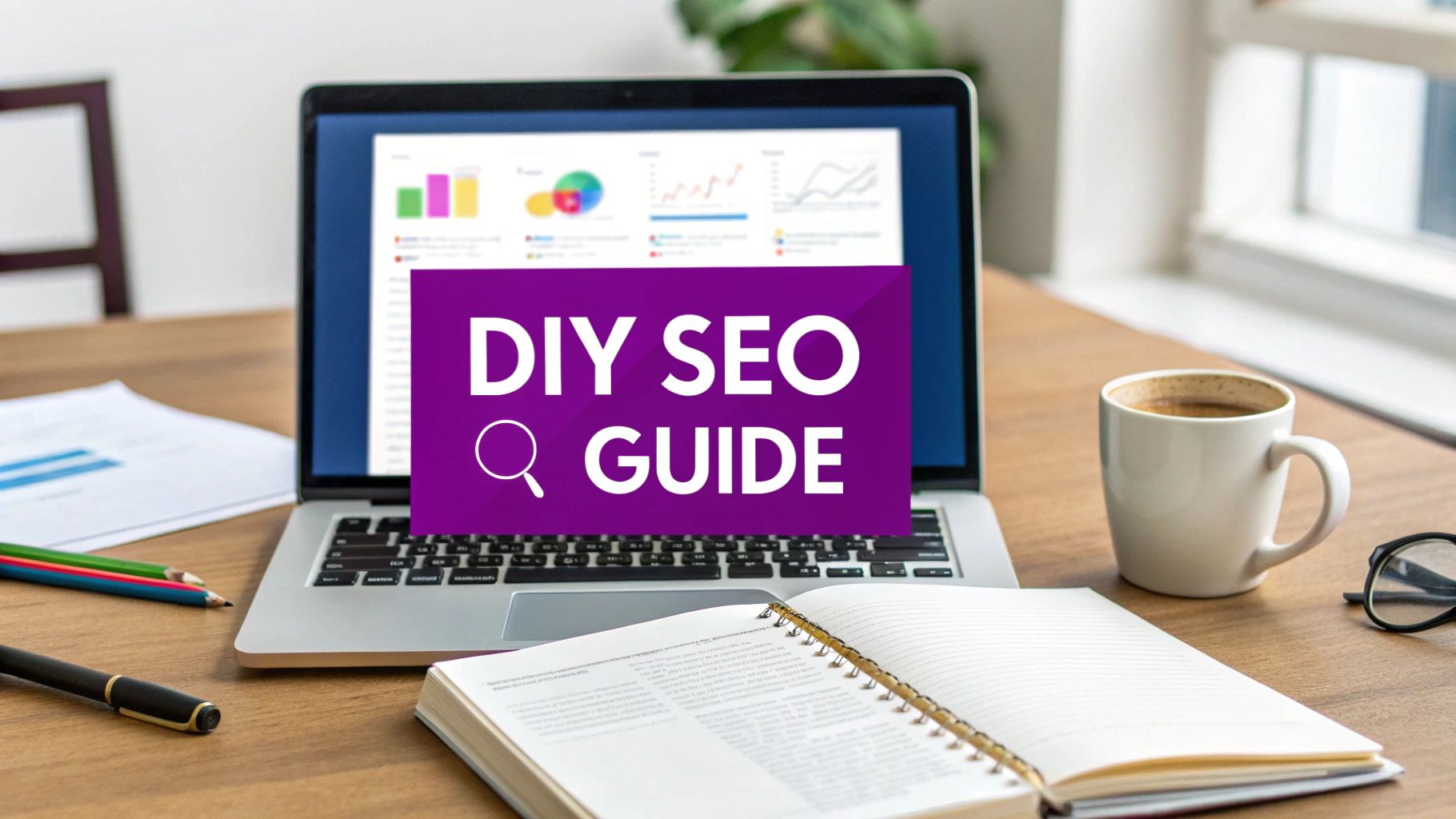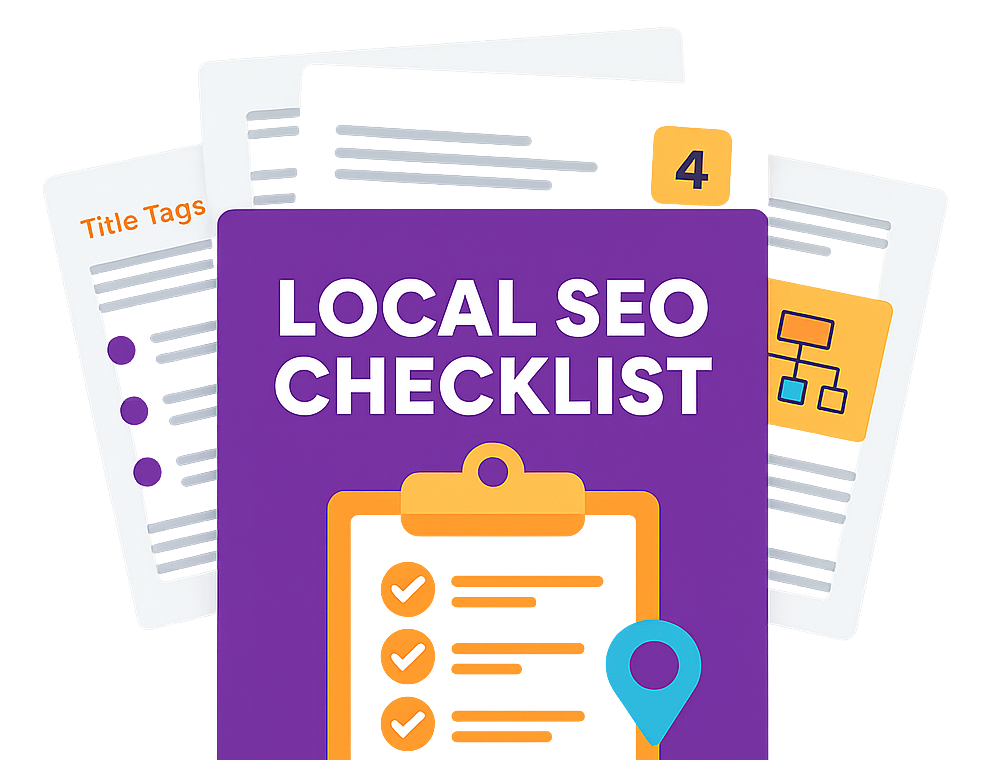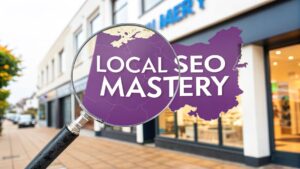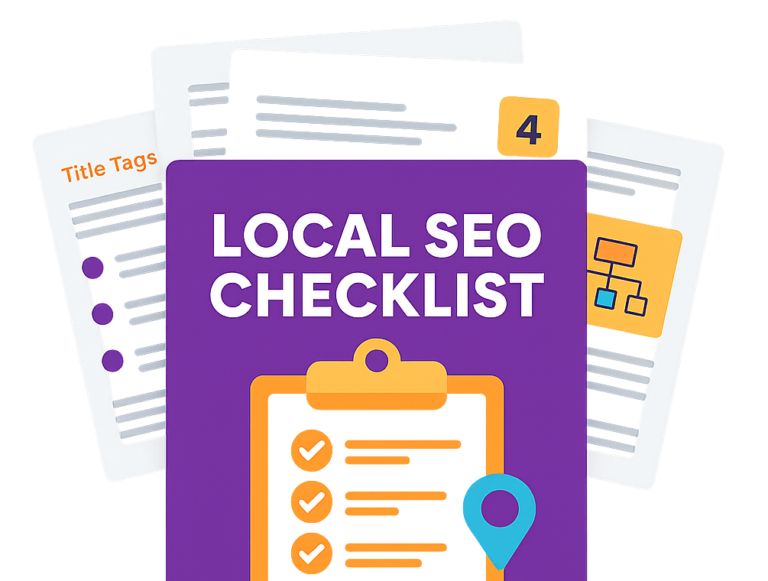Thinking about doing your own SEO? It’s a lot more achievable than you might think. At its core, DIY SEO boils down to a few key things: figuring out what your customers are actually searching for, creating genuinely helpful content that answers their questions, and making sure Google can easily read and understand your website.
It's a continuous loop of research, optimisation, and checking your results to see what’s working.
Your Realistic Starting Point for DIY SEO
Diving into the world of search engine optimisation can feel overwhelming, but honestly, it’s one of the most valuable skills you can build for your business. The fundamental idea is pretty simple: make your website incredibly clear for search engines and genuinely useful for people. Nail that balance, and you’re well on your way.
The opportunity here is massive. By 2023, the UK’s SEO market was already valued at around £19.2 billion and continues to grow. Think about it: 42% of UK consumers turn to search engines first when looking for products or services. That's more than double the number who use social media, proving just how vital a strong Google presence is for finding new customers.
The Three Pillars of SEO
To keep things from getting too complicated, it helps to think of your DIY SEO strategy as resting on three main pillars. Each one supports the others, and together they create a solid foundation for your website to climb the rankings.
To keep it simple, here’s a quick breakdown of what you need to focus on for a solid DIY SEO strategy.
Core Pillars of a DIY SEO Strategy
| SEO Pillar | Primary Goal | Key Activities |
|---|---|---|
| Technical Health | Make it easy for search engines to find and understand your site. | Fixing broken links, improving site speed, ensuring mobile-friendliness. |
| On-Page Content | Create high-quality, relevant content for your audience. | Keyword research, writing valuable blog posts, optimising page titles. |
| Off-Page Authority | Build your website's reputation and credibility online. | Earning backlinks from other reputable sites, managing online reviews. |
These three areas are the foundation of any successful self-managed SEO plan. Get these right, and you'll be ahead of the game.
This infographic really brings to life the workflow you'll be following. It's a cycle of research, action, and analysis.

As the visual shows, good SEO isn't a one-and-done task. It’s a continuous loop. The data you get from your analytics will directly inform your next round of keyword research and content tweaks.
Essential Free Tools for Beginners
The great news is you don't need a huge budget to get started. In fact, two of the most powerful tools are completely free, courtesy of Google. These are non-negotiable for anyone serious about managing their own SEO.
Your very first practical step should be setting up Google Search Console and Google Analytics. This duo is your command centre. It allows you to track your progress right from day one and make decisions based on real data, not just guesswork.
If you’re looking to get up to speed quickly, it's worth exploring some of the top SEO courses out there. A structured course can build your skills and confidence much faster than trying to figure everything out through trial and error.
With these foundational tools and a clear focus on the three pillars, you’ll be in a great position to take control of your online presence.
Finding Keywords That Actually Drive Business
Great SEO isn't about chasing obscure technical terms. It starts with something much more fundamental: understanding the exact words and phrases your customers use when they need what you sell. This process, known as keyword research, is all about aligning your website's language with real-world customer problems.
Get this right, and you stop wasting time on vanity traffic. Instead, you start attracting visitors who are genuinely interested in what you have to offer.
The goal is to stop guessing. Think about the last ten conversations you had with customers. What specific problems did you solve? What questions did they keep asking? Those are your seed keywords—the authentic starting points for your research.
Decoding Search Intent
Before you even think about opening a tool, you need to get your head around search intent. This is the why behind every single search query. Is someone looking to buy now (transactional intent), learn something (informational intent), find a specific site (navigational intent), or compare their options before making a decision (commercial investigation)?
For example, a search for "best running shoes for flat feet" signals commercial investigation. They're getting close to buying but need a bit more info. On the other hand, someone searching for "Nike Pegasus 41 price" is ready to pull out their wallet—that's clear transactional intent. Matching your content to the user's intent is absolutely critical if you want to rank well and keep visitors happy.
Here's a key takeaway: Don't just collect a list of keywords. For each one, ask yourself, "What does this person really want to do?" Answering that question will completely change how you write your content and make it far more effective.
Using Free and Paid Tools for Insights
The good news? You don't need a massive budget to get started. Free tools can give you more than enough data to build a solid foundation. Google's Keyword Planner is a fantastic resource. It was built for advertisers, but it’s just as valuable for SEO, helping you find new keywords and see how many people are searching for them each month.
Here’s a glimpse of what Keyword Planner looks like when it presents keyword ideas and their search volumes.

As you can see, it gives you hard data on monthly search volumes, which is essential for figuring out where to focus your energy. While these free tools are powerful, paid platforms like Semrush or Ahrefs can seriously speed up your research with more detailed data, competitor insights, and keyword difficulty scores.
The Power of Long-Tail Keywords
When you're just starting your DIY SEO journey, it’s so tempting to go after the big, broad, high-volume keywords like "plumber" or "accountant." Don't. These terms are incredibly competitive, and you'll struggle to make a dent. The real opportunity for small businesses is in long-tail keywords.
These are longer, more specific phrases, usually three or more words, like "emergency plumber for leaking boiler in Cambridge." They might have lower search volumes on their own, but they have some serious advantages:
- Higher Conversion Rates: The search is so specific that the person is often much closer to making a purchase.
- Lower Competition: Far fewer websites are trying to rank for these exact phrases, giving you a much better shot at hitting the first page.
- Clearer Intent: You know exactly what the searcher needs, which makes it incredibly easy to create perfectly targeted content that solves their problem.
Think of it this way: broad keywords are like casting a giant net in the open ocean. You might catch something, but it’s a lot of work for an uncertain return. Long-tail keywords are like using the perfect bait in a small, well-stocked pond.
Organising Keywords into a Content Plan
By now, your research will have probably unearthed hundreds, if not thousands, of potential keywords. The final step is to bring some order to the chaos by grouping them into logical topic clusters. This turns a messy spreadsheet into a clear roadmap for your content.
First, identify your main "pillar" topics—these are the broad subjects you want to be known for, like "Small Business Accounting." Then, group related long-tail keywords into clusters that sit underneath each pillar. For that "Small Business Accounting" pillar, you might have clusters for:
- VAT returns for sole traders
- Choosing accounting software
- How to calculate corporation tax
This structure doesn't just help you plan your content; it also helps Google understand that your website is an authority on a particular subject. If you want to speed this up, exploring how to use AI for SEO can uncover new ways to analyse and categorise keywords far more efficiently. A structured approach like this is what turns a simple list of keywords into a powerful, strategic content plan that will guide your entire website.
On-Page SEO: How to Optimise Your Content
Right, you've got your keywords. Now it's time to actually put them to work by weaving them into the very fabric of your website. This is what we call on-page optimisation, and it's probably the most direct way you can signal your value to both search engines and potential customers. If you're learning how to do SEO yourself, getting this bit right is non-negotiable.
Think of it like setting up a physical shop. You wouldn't just chuck your products in a messy pile, would you? Of course not. You'd arrange them neatly, use clear signs, and create an appealing window display. On-page SEO is the digital equivalent for your website's pages.

Crafting Titles and Descriptions People Actually Click On
Your page title (or title tag) and meta description are your first handshake with a potential customer in Google's search results. They act as your digital billboard, and their only job is to convince someone to click on your link instead of the nine others on the page.
A great title needs to be concise—aim for under 60 characters—and must include your primary keyword. It should also spark a bit of curiosity or just plainly state the value you're offering. The meta description (you've got about 155 characters to play with) is your supporting sales pitch. It should build on the title, use your keyword, and end with a compelling reason to click.
For instance, a generic title like "Plumbing Services" is a wasted opportunity. A much better version would be:
- "Emergency Boiler Repair Cambridge | 24/7 Call Out | Bare Digital"
See the difference? This one is specific, targets a real-time need ("emergency"), includes a location, and even adds a trust signal ("24/7 Call Out").
Structuring Content for Readability and Relevance
Nobody enjoys reading a solid wall of text. It’s intimidating. That's why structuring your content with headings is so important, not just for the reader's sanity but for signalling what your page is about to Google.
Every page should have one, and only one, H1 tag. This is your main page title. It needs to clearly state the page's purpose and contain your main keyword. From there, use H2 and H3 subheadings to break your content into logical, scannable sections. This simple organisation makes your content far easier to digest and helps search engines understand the hierarchy of your information.
Think of your headings as a table of contents for the page. A visitor should be able to scan your H1, H2s, and H3s and get a complete picture of what your content covers without reading a single paragraph. This structure is a cornerstone of good on-page SEO.
While getting a handle on on-page optimisation for your existing content is a massive step forward, some businesses find they need to scale their efforts. That's often when they turn to professional content creation agencies to produce high-quality, optimised articles consistently.
The Finishing Touches: Image Alt Text and Clean URLs
Two often-forgotten elements of on-page SEO are image optimisation and URL structure. They might feel like small details, but they add up to create a polished, professional, and well-optimised page that both users and search engines appreciate.
Image Optimisation:
- Descriptive Alt Text: Every single image needs alt text. This short description tells visually impaired users what the image shows and gives search engines crucial context. Instead of
alt="image123.jpg", use something descriptive likealt="A modern kitchen with a newly installed quartz worktop". - Relevant File Names: Before you even upload an image, rename the file to something that makes sense. A file named
new-kitchen-worktop-cambridge.jpgis infinitely better for SEO thanIMG_9876.jpg.
Clean URLs:
Your page's URL should be short, easy to read, and include your primary keyword. A clean URL helps everyone understand what the page is about with just a glance.
- Poor URL:
https://www.yourwebsite.co.uk/p?id=123&category=services - Good URL:
https://www.yourwebsite.co.uk/services/emergency-boiler-repair
These small details really do matter. They contribute to a much better user experience, which is exactly what search engines are designed to reward. By focusing on these on-page fundamentals, you’re building a strong foundation for your DIY SEO, making your content more accessible and far more likely to rank for the keywords that bring in business.
Building Authority with Modern Link Building
Once you’ve sorted your on-page content, the next big challenge in your DIY SEO mission is building authority. This is where off-page SEO comes into play, and its most valuable currency is the backlink—a link pointing from another website to yours.
Think of every good backlink as a vote of confidence. It’s a signal to Google that your site is a credible, trustworthy resource worth showing to more people.
The aim isn't to just hoard as many links as you can. That’s an outdated and risky game. Today, modern link building is all about earning genuine endorsements through quality and relevance. It’s a strategic game of proving your expertise and building relationships across the web.

Find Guest Posting Opportunities
One of the most tried-and-tested ways to build authority and earn high-quality backlinks is through guest posting. This is where you write an article for another website in your industry. You give them valuable content for their audience, and in return, you usually get a link back to your site, either in the content itself or in your author bio.
Finding these opportunities is easier than you think. Just fire up Google and try these simple search queries:
"your industry" + "write for us""your keyword" + "guest post""your topic" + "contribute an article"
Be selective. Focus your energy on reputable blogs and industry publications. A single link from a well-respected site is worth far more than dozens from low-quality or irrelevant ones. It’s all about association; if a trusted site links to you, some of that trust gets passed on to your website.
Create Linkable Assets
A "linkable asset" is a piece of content on your site that’s so valuable, useful, or unique that other people can’t help but link to it. Instead of actively begging for links, you create something that earns them naturally. This is the absolute foundation of a sustainable, long-term link-building strategy.
Think about creating a resource that you wish existed when you were first learning your trade. If you find it valuable, it's highly likely that others in your industry will too. This is the secret to creating content that people genuinely want to share and reference.
Here are a few ideas for powerful linkable assets:
- In-depth Guides: The ultimate, definitive guide to solving a common problem in your field.
- Original Research or Surveys: Collect unique data and present your findings in a compelling report or infographic.
- Free Tools or Calculators: Build a simple tool that helps your audience achieve a specific task.
- Expert Roundups: Create an article featuring insights and quotes from multiple experts on a single topic.
This approach takes more effort up front, but the payoff is immense. A single, high-quality asset can keep attracting backlinks and driving traffic for years. For more advanced ideas, you can dive into our detailed guide on how to build backlinks to really level up your strategy.
Leverage Local Business Directories
For any business serving a specific geographic area, local business directories are a goldmine for foundational backlinks. These citations don’t just provide a link; they also reinforce your location and contact information, which is absolutely critical for local SEO.
Start with the big ones:
- Google Business Profile: This is non-negotiable. Make it your top priority.
- Bing Places for Business: Don’t ignore the second-largest search engine; it's still a valuable source of traffic.
- Yell, Thomson Local, and other UK-specific directories: Zero in on well-known and reputable UK-based listings.
Consistency is everything here. Make sure your business name, address, and phone number (NAP) are identical across every single listing. Any inconsistencies can confuse search engines and water down the value of your citations.
Monitor Your Backlink Profile
As you start earning links, it’s vital to keep an eye on who is linking to you. You can use tools like Google Search Console (check the "Links" report) to get a basic overview completely free. This lets you see your top linking sites and understand which content is resonating enough to earn links.
Monitoring helps you spot both the good and the bad. If you notice a flood of spammy or low-quality sites pointing your way, you might need to disavow them. More importantly, it shows you what’s working so you can double down on the tactics that are actually delivering results.
Technical SEO Essentials for a Healthy Website
Let's talk about the engine room of your website: technical SEO. It might sound complex, but at its heart, it’s all about making sure search engines can find, crawl, and understand your site without any roadblocks. Think of it as the solid foundation you build your house on.
You don't need to be a coding whizz to handle the basics. Getting these fundamentals right ensures that all the time and effort you pour into creating great content actually pays off. It’s an area where a little bit of know-how goes a very long way.
Make Your Site Mobile-Friendly
It’s no longer a suggestion—it’s a requirement. More people are likely to find you on their phone than on a desktop, and Google's "mobile-first" approach means it ranks your site based on the mobile experience.
If your site is a pain to use on a phone—think tiny text, links you can't tap, or endless side-scrolling—you’re not just frustrating visitors. You’re sending a clear signal to Google that your site offers a poor user experience, which can hurt your rankings. You can quickly see how you stack up with Google's free Mobile-Friendly Test tool.
Boost Your Page Speed
We’ve all done it. Click on a link, wait… and wait… and then hit the back button. Page speed is a massive factor for both your visitors and your SEO. A slow site leads to a high bounce rate, and that’s a red flag for search engines.
A great starting point is Google's PageSpeed Insights. It gives you a performance score and, more importantly, a to-do list for making things faster. Common culprits include:
- Bloated Images: Large image files are a primary cause of slow pages. Compressing them is a quick win.
- Messy Code: Minimising your site's CSS and JavaScript files can clean things up and improve load times.
- Slow Hosting: Sometimes, the problem is your server. A slow server response time will always hold you back.
Seriously, even shaving off a single second can make a real difference in keeping people on your site.
A critical part of DIY SEO is realising that user experience is SEO. A fast, easy-to-use site keeps visitors happy, and what keeps visitors happy generally keeps Google happy too. It’s a direct and powerful connection.
Guide Search Engines with Sitemaps and Robots.txt
You need to give search engines clear directions. An XML sitemap is essentially a map of all your important pages that you hand over to Google and Bing. It helps their crawlers see everything you want them to see, so no valuable content gets missed. Most modern platforms like WordPress will generate one for you.
On the flip side, your robots.txt file is a set of "do not enter" signs. It tells crawlers which parts of your site to ignore, like admin login pages or internal search results. Getting this wrong can be disastrous, but getting it right is a fundamental step. For anyone on WordPress, digging into guides on WordPress robots.txt optimisation is well worth the time to make sure you’re not accidentally blocking important content.
Secure Your Site with HTTPS
That little padlock in the browser's address bar matters. An SSL certificate (which turns your site's address from HTTP to HTTPS) is a confirmed, if minor, ranking signal. More importantly, it secures the connection between your visitor's browser and your site.
These days, browsers like Chrome will flat-out label non-HTTPS sites as "Not Secure." That's a huge turn-off for potential customers and can destroy trust in an instant. Most web hosts offer free SSL certificates, and enabling one is usually a simple, one-click process. It's an easy fix that adds a crucial layer of credibility.
Essential DIY SEO Tool Comparison
A good toolkit makes any job easier. Here’s a look at popular free and paid tools to help you manage your SEO strategy effectively.
| Tool Category | Free Option (Example) | Paid Option (Example) | Primary Use Case |
|---|---|---|---|
| All-in-One SEO Suite | Google Search Console | Ahrefs / Semrush | Keyword tracking, backlink analysis, site audits |
| Keyword Research | Google Keyword Planner | AnswerThePublic | Finding new content ideas and search terms |
| Technical & Speed | Google PageSpeed Insights | Screaming Frog | Analysing site speed and technical health |
| Content Optimisation | Hemingway App | Surfer SEO | Improving readability and on-page SEO factors |
While free tools are fantastic for getting started, paid platforms often provide deeper insights and competitive analysis that can give you a real edge.
If you want to dive deeper and work through these points systematically, our technical SEO audit checklist provides a complete, step-by-step guide. It covers everything mentioned here and more, helping you spot and fix issues like a pro.
The growth in powerful SEO tools has been massive. In 2024, the UK SEO software market generated £4.3 billion in revenue and is projected to smash £9 billion by 2030. This boom means there are more accessible and powerful resources than ever for SMEs looking to handle their own SEO and make data-driven decisions.
Got Questions About DIY SEO? We’ve Got Answers
Stepping into the world of SEO for the first time always brings up a few questions. It’s completely natural to wonder if you’re on the right track or if all this effort is actually going to pay off. We hear the same queries all the time, so we’ve put together some straightforward answers to help you get started with confidence.
When you’re going it alone, it pays to know where the common tripwires are. So many small businesses stumble over the same hurdles when they first start out. Getting a heads-up on these can save you a mountain of time and frustration, so it’s well worth reading up on the 5 common SEO mistakes small businesses make to get ahead of the curve.
How Long Does DIY SEO Take to Show Results?
This is the million-pound question, and the honest-to-goodness answer is: it depends. SEO is a marathon, not a sprint, and anyone who tells you otherwise is selling snake oil.
You can generally expect to see some flickers of life—some initial movement in your rankings—within three to six months. This is usually for less competitive, long-tail keywords.
But for the more competitive search terms that really drive traffic and leads, you should be thinking in terms of six to twelve months of consistent work. Several things can speed this up or slow it down:
- Your Industry's Competitiveness: A local dog groomer in a small town is going to see results much faster than a national e-commerce brand selling clothes. It’s just a different ball game.
- Your Website's Age and Authority: An established website with a bit of history has a head start. A brand-new domain is starting from scratch.
- Your Consistency: This is the big one. SEO rewards steady, consistent effort. A few hours put in every single week will build momentum and compound over time, far more than one big push followed by months of silence.
Think of it like planting a tree. You won’t get a towering oak overnight, but with consistent care, you’ll see steady growth that eventually becomes a strong, lasting asset.
Can I Really Do SEO Myself Without Being an Expert?
Yes, absolutely. You don't need to be a coding genius or a technical whizz to get the fundamentals of SEO right. The most important things you need are a willingness to learn, a bit of patience, and a genuine drive to give your customers what they're looking for.
Here’s the thing: you already have one massive advantage over any agency you could hire. You know your business and your customers inside and out.
That deep, firsthand knowledge is your secret weapon. It allows you to create authentic, genuinely helpful content that speaks directly to your audience. The technical checks and the tools? Those are just skills you can learn. But that customer insight? That’s something you already own.
At its heart, good SEO is just about making your website the best possible answer to a potential customer's question. If you focus on that, you’re already 80% of the way there.
How Much Does DIY SEO Cost?
One of the biggest draws of handling your own SEO is, of course, saving money on agency fees. And while that’s true, it’s not entirely free. Your biggest investment will be your time, but there are a few other potential costs to keep in mind.
Here’s a realistic look at what you might spend:
| Cost Type | Example | Typical Cost (GBP) |
|---|---|---|
| Time Investment | Research, writing, optimising | Your most valuable resource. |
| SEO Tools (Optional) | Ahrefs, Semrush, SurferSEO | £80 – £400+ per month |
| Website Hosting | A reliable, fast server | £10 – £50 per month |
| Content Assets | Stock photos, graphic design | Variable |
You can get a huge amount done with fantastic free tools like Google Analytics, Google Search Console, and Google Keyword Planner. Paid tools can definitely speed things up, but they aren’t a must-have when you’re just starting. The biggest "cost" is simply the hours you put into learning the ropes and putting your plan into action.
Which SEO Task Should I Focus on First?
It's so easy to get overwhelmed. The list of things you could be doing is endless. So, if you're stuck wondering where on earth to begin, my advice is always to start with the tasks that will give you the most bang for your buck.
- Get Your Measurement Tools in Place: Before you touch anything else, install Google Analytics and get your site verified with Google Search Console. It's simple: you can't improve what you don't measure.
- Do Your Keyword Research: Don't try to boil the ocean. Identify a small, manageable list of 5-10 long-tail keywords. Look for phrases that show someone is ready to buy and are highly relevant to what you sell.
- Nail Your On-Page Optimisation: Pick one of your most important service pages. Just one. Optimise it for a single target keyword from your list. Get its title tag, meta description, and content structure spot on.
By starting with a single page, you make the whole process feel less intimidating and you learn the fundamentals by doing. Once you've optimised that page and seen it start to climb, you’ll have the confidence—and the blueprint—to do it again across your entire site.
Feeling ready to move beyond the basics? The team at Bare Digital offers a free SEO Health Check to give you a clear, actionable plan. Discover exactly where your opportunities lie and how to achieve measurable results. Find out more at https://www.bare-digital.com.








